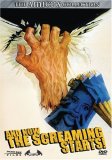Severed hand films. Gotta love ’em. Not because they’re necessarily good, as such. The ones that have been (the various versions of The Hands of Orlac, or The Beast with Five Fingers) have been, ultimately, psychological thrillers. There have been honest-to-god crawling hands, of course, in wonders such as Evil Dead 2: Dead By Dawn, but Bruce Campbell’s misbehaving limb was a supporting character, rather than the central menace. But I return to my initial statement. Even if the film isn’t that good (or good at all), you have to love it for the crawling hand.
Which brings me to And Now the Screaming Starts, a 1972 effort now out on a fine DVD from Dark Sky Films as part of their Amicus Collection (available in a box set along with Asylum and The Beast Must Die). Amicus, as I’m sure many of you already know, was one of Hammer’s principle competitors in that period with the British Gothic held sway at the box office. Where Hammer made a speciality of revisiting classic monsters (the Frankenstein monster, Dracula, etc.), Amicus was best known for the anthology movie, almost invariably with Peter Cushing showing up in one capacity or another. These are the films for which the studio is still remembered fondly today. But there were a few exceptions, a few single story films, and Screaming Starts is one of them. Based on the novel Fengriffen (which was one of the alternate titles for the film, and one that makes a bit more sense), this sees Stepahnie Beacham as the new bride of Ian Ogilvy, last of the Fengriffen line. In 1795, they arrive at his ancestral home, and on her wedding night, Beacham is assaulted by a severed hand and ghost with a bloody stump. The true extent of the attack isn’t immediately clear, but Beacham is understandably extremely upset, especially since she continues to have terrifying visions. Her state of mind is not helped by the fact that not only is there obviously a terrible secret in the Fengriffen family’s past, and everyone but her knows what it is, and no one will speak of it, but the few who do try to divulge the secret die immediately (usually courtesy of the phantom limb). Without giving too much away, it turns out, quite naturally, that all the badness is due to the sins of fathers being visited upon later generations. Brought in to help is Peter Cushing as Dr. Pope, an early psychologist, and he finds himself out of his depth in pretty short order.
Phil Hardy’s Encyclopedia of Horror Movies criticizes the film for missing an opportunity to make more of the class warfare suggested by the story, but I think, all things considered, that this judgment is a little bit harsh. Class is very present in the film, and, in a work that is prone to some rather hamfisted techniques (notably the organ histrionics on the score), there is one scene that conveys the depth of the conflict with admirable subtlety. As Beacham walks in the woods, she passes by two woodsmen. They regard her with a mixture of curiosity and resentment, while she, our most sympathetic character, nevertheless gazes at them with both discomfort and superiority. It is that discomfort of hers, that recognition of an injustice that privileges her, that, I think, goes some way toward explaining the striking and complex facial expression she bears in the film’s last scene.
Don’t get me wrong. The cheese is here, particularly at the level of the FX (though there is one nicely startling jump moment), and this is not in the first rank of British Gothics, nor in the second. But is isn’t dull, it’s got a sick kick to its conclusion, and it still features some intelligent storytelling of a sort that seems too rare today. (Just listen to me turning into an old fart.)


